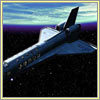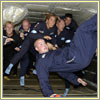
High-Tech Tourism
Until recently the only people who could visit the most
extreme environments, such as the ocean floor or outer space,
were highly trained, often government-funded specialists like
scientists, astronauts, and fighter pilots. But all that is
changing. Today, or in the not-too-distant future, private
individuals with the moxie and the money can or will soon be
able to travel just about anywhere on or above Earth. In this
slide show, get a taste of the possibilities.—Gaia Remerowski


|
|
Visiting the space station
Approximate cost per trip:
$20 million (add $15
million for the spacewalk)
Riding in a Russian Soyuz spacecraft, well-heeled
individuals can now play astronaut and visit the
International Space Station 250 miles above Earth. Soon
they will also be able to suit up and take a spacewalk
around the station lasting up to one-and-a-half hours.
The 10-day trip requires months of training alongside
actual astronauts, and some health risks are involved:
prolonged weightlessness can wreak havoc on the body,
and the long-term effects of space radiation remain
unclear. But that hasn't lessened interest among the
superrich, four of whom have already taken the trip.
|


|
|
Going suborbital
Estimated cost per trip: $200,000
Individuals will soon be able to travel into suborbital
space, the region just above Earth's atmosphere that
begins at about 62 miles up. With less than a week of
training, travelers will be shuttled to this suborbital
point for a 15-minute ride, including five minutes of
weightlessness. Passengers will be able to see the
rounded blue edge of Earth below and the black of space
above. Companies are now competing to develop a
low-cost, reusable shuttle that will make these
suborbital trips possible.
|


|
|
Experiencing weightlessness
Approximate cost per flight: $4,000
Would-be astronauts can now experience zero gravity
without leaving the Earth's atmosphere. A modified
Boeing 727-200 jet takes passengers high in the sky,
then flies in a special parabolic flight path. As the
plane arcs, defying the force of gravity, passengers
float through the padded cabin almost as if they were
flying through the air. A typical flight lasts about an
hour and a half, with the parabolic arcs occurring
between about 24,000 and 34,000 feet. The higher the
arc, the more weightlessness one feels. Almost anyone
can participate, but the sensation can induce motion
sickness in some (hence the nickname astronauts give
their similar training plane, the "vomit comet").
|


|
|
Diving below the North Pole
Estimated cost: $95,000
Travelers will soon be able to visit the "real" North
Pole by diving down 14,000 feet to the bottom of the top
of the world. A chartered nuclear-powered icebreaker
will shuttle passengers to the pole, then one of two MIR
submersibles will take passengers to the Arctic Ocean
floor. Passengers will be able to peer through
seven-inch-thick acrylic portholes at deep-sea scenery
illuminated by the MIR's exterior lights. The expedition
to the pole is a one-time event, and the MIR dives will
take place in summer 2008.
|


|
|
Descending to the Titanic
Approximate cost: $40,000
Fans of the movie Titanic and other shipwreck
aficionados can now descend two and a half miles in a
MIR submersible for an up-close view of the actual
Titanic. Dives on the MIRs last 10 to 12 hours,
as passengers are piloted around the wreck to appreciate
its massive size and once-majestic quarters. Sites
visited include the captain's quarters, the huge
propellers, and, of course, the bow with the now-famous
railing. Specialized underwater cameras record the
expedition.
|


|
|
Piloting a personal sub
Approximate cost:
$15,000 for lessons,
$10,000/day to operate the ship
Would-be Captain Nemos can learn to pilot a one- to
two-person sub themselves. The trip requires a three-day
course at an underwater "flight school," where potential
pilots learn how to operate the battery-powered sub.
Then, with underwater pilot's license in hand, they can
strap themselves into the sub and head off on a personal
journey. Just over 10 feet long, the subs can descend to
depths of 3,000 feet and can travel much faster and
maneuver within tighter spaces than traditional
submarines. A newer, sleeker version of the sub is
slated to launch in 2007.
|


|
|
Flying a MiG fighter
Approximate cost: $19,000
Top Gun enthusiasts can now fly a legendary MiG,
the famed Russian fighter plane first used in World War
II. Current versions of these jets travel faster than
the speed of sound and can climb as high as 70,000 feet
(close to the edge of space). Anyone over 16 with no
major health problems is eligible to fly. Though an
experienced co-pilot performs most of the flying,
passengers can try certain maneuvers. The 30-minute
flights, available only in Russia, take place in MiG
models ranging from the Fulcrum (similar to an F-18) to
the Foxhound, a top-of-the-line combat aircraft.

|
|

|







